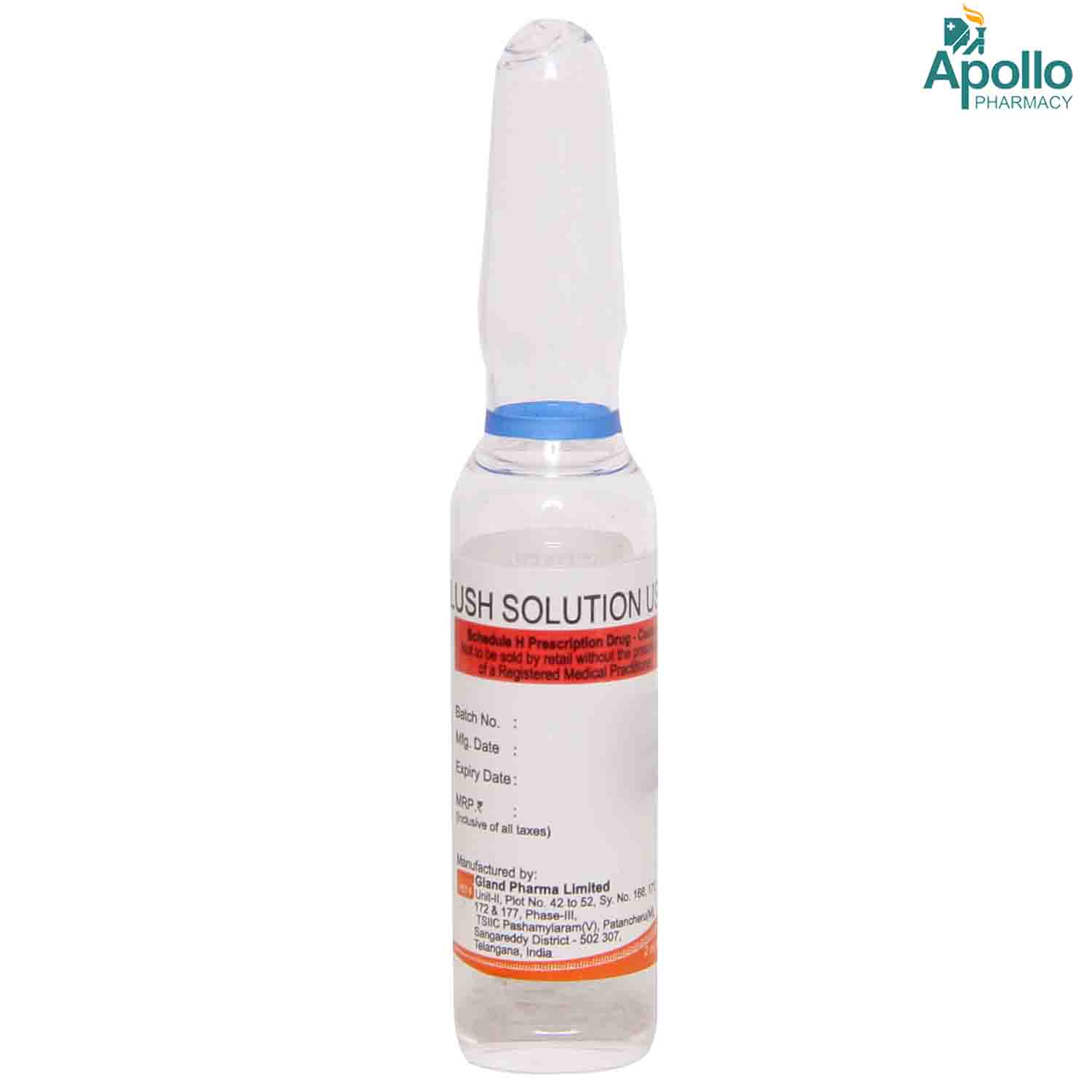Cathflush Injection

MRP ₹55
(Inclusive of all Taxes)
₹8.3 Cashback (15%)
know your delivery time
Provide Delivery Location
Composition :
Manufacturer/Marketer :
Consume Type :
Expires on or after :
Return Policy :

Secure Payment

Trusted by 8 Crore Indians

Genuine Products
Therapeutic Class
Author Details
We provide you with authentic, trustworthy and relevant information
FAQs
Disclaimer
Alcohol
Pregnancy
Breast Feeding
Driving
Liver
Kidney
Children
Product Substitutes
About Cathflush Injection
Uses of Cathflush Injection
Medicinal Benefits Mweb
Key Benefits
Directions for Use
Side Effects of Cathflush Injection
Drug Warnings
Drug-Drug Interactions
Drug-Drug Interactions
Login/Sign Up
Taking Ticlopidine with Cathflush Injection 10 ml can increase the risk of bleeding.
How to manage the interaction:
Taking Ticlopidine with Cathflush Injection 10 ml is not recommended as it can result in an interaction, it can be taken if a doctor has advised it. Do not discontinue any medications without a doctor's advice.
Taking Tenecteplase with Cathflush Injection 10 ml can increase the risk of bleeding.
How to manage the interaction:
Taking Cathflush Injection 10 ml with Tenecteplase is not recommended as it can result in an interaction, it can be taken if a doctor has advised it. However, if you notice unusual bleeding or bruising, vomiting, blood in your urine or stools, headache, dizziness, or weakness, consult a doctor immediately. Do not discontinue any medications without a doctor's advice.
When Cathflush Injection 10 ml is taken with bazedoxifene the effects of Cathflush Injection 10 ml are reduced by bazedoxifene.
How to manage the interaction:
Taking Bazedoxifene with Cathflush Injection 10 ml is not recommended as it can result in an interaction, it can be taken if a doctor has advised it. Do not discontinue any medications without a doctor's advice.
Using Cathflush Injection 10 ml with Oritavancin can make Cathflush Injection 10 ml less effective as a therapy.
How to manage the interaction:
Cathflush Injection 10 ml is not recommended within 120 hours (5 days) of taking oritavancin. Oritavancin can interfere with certain of the major coagulation tests used to assess Cathflush Injection 10 ml's effectiveness and safety, it can be taken only if prescribed by a doctor. Do not discontinue any medications without a doctor's advice.
Taking Mifepristone with Cathflush Injection 10 ml can increase the risk of negative side effects.
How to manage the interaction:
Taking Cathflush Injection 10 ml with Mifepristone is not recommended as it can result in an interaction, it can be taken if a doctor has advised it. Do not discontinue any medications without a doctor's advice.
Taking Alteplase with Cathflush Injection 10 ml can increase the risk of bleeding.
How to manage the interaction:
Taking Cathflush Injection 10 ml with Alteplase is not recommended as it can result in an interaction, it can be taken if a doctor has advised it. However, if you have unusual bleeding or bruising, vomiting, blood in your urine or stools, headache, dizziness, or weakness, consult a doctor immediately. Do not discontinue any medications without a doctor's advice.
Co-administration of Ibrutinib with Cathflush Injection 10 ml can increase the risk of bleeding.
How to manage the interaction:
There may be a possibility of interaction between Ibrutinib and Cathflush Injection 10 ml, but it can be taken if prescribed by a doctor. However, consult a doctor, if you experience any unusual bleeding or bruising, dizziness, lightheadedness, red or black, tarry stools, coughing up or vomiting fresh or dried blood that looks like coffee grounds, severe headache, and weakness. Do not stop using any medications without a doctor's advice.
Taking Cathflush Injection 10 ml with Enoxaparin may increase the risk of bleeding.
How to manage the interaction:
There may be a possibility of interaction between Cathflush Injection 10 ml and Enoxaparin, but it can be taken if prescribed by a doctor. However, consult a doctor, if you experience any unusual bleeding or bruising, dizziness, lightheadedness, red or black, tarry stools, coughing up or vomiting fresh or dried blood that looks like coffee grounds, severe headache, and weakness. Do not stop using any medications without a doctor's advice.
Taking Cathflush Injection 10 ml with Omacetaxine mepesuccinate can increase the risk of bleeding.
How to manage the interaction:
Co-administration of Omacetaxine mepesuccinate with Cathflush Injection 10 ml can result in an interaction, but it can be taken if a doctor has advised it. However, if you experience any unusual bleeding or bruising, dizziness, lightheadedness, red or black, tarry stools, coughing up or vomiting fresh or dried blood that resembles coffee grounds, severe headache, and weakness, consult a doctor. Do not discontinue any medications without consulting a doctor.
Taking Cathflush Injection 10 ml with Urokinase can increase the risk of bleeding.
How to manage the interaction:
Co-administration of Cathflush Injection 10 ml with Urokinase can result in an interaction, but it can be taken if a doctor has advised it. However, if you have unusual bleeding or bruising, vomiting, blood in your urine or stools, headache, dizziness, or weakness, consult a doctor immediately. Do not stop using any medications without a doctor's advice.
Drug-Food Interactions
Drug-Food Interactions
Login/Sign Up
Drug-Diseases Interactions
Drug-Diseases Interactions
Login/Sign Up
Drug-Drug Interactions Checker List
Habit Forming
Special Advise
All Substitutes & Brand Comparisons
RX
Caprin Flush Injection 10 ml
Samarth Life Sciences Pvt Ltd
₹42
(₹3.78/ 1ml)
31% CHEAPERRX
Heplock Injection 2 ml
Gland Pharma Ltd
₹18
(₹8.1/ 1ml)
47% COSTLIERRX
Cathflush Injection 2 ml
Troikaa Pharmaceuticals Ltd
₹18
(₹8.1/ 1ml)
47% COSTLIER

Have a query?
Buy best Cardiology products by
Torrent Pharmaceuticals Ltd
Sun Pharmaceutical Industries Ltd
Lupin Ltd
Intas Pharmaceuticals Ltd
Cipla Ltd
Micro Labs Ltd
Macleods Pharmaceuticals Ltd
Abbott India Ltd
Ajanta Pharma Ltd
Ipca Laboratories Ltd
Eris Life Sciences Ltd
Mankind Pharma Pvt Ltd
Lloyd Healthcare Pvt Ltd
Dr Reddy's Laboratories Ltd
Glenmark Pharmaceuticals Ltd
Emcure Pharmaceuticals Ltd
Alembic Pharmaceuticals Ltd
Alkem Laboratories Ltd
East West Pharma India Pvt Ltd
USV Pvt Ltd
Zydus Healthcare Ltd
Aristo Pharmaceuticals Pvt Ltd
Elbrit Life Sciences Pvt Ltd
J B Chemicals & Pharmaceuticals Ltd
Zydus Cadila
Akumentis Healthcare Ltd
Alteus Biogenics Pvt Ltd
Hbc Life Sciences Pvt Ltd
Fusion Health Care Pvt Ltd
Troikaa Pharmaceuticals Ltd
La Renon Healthcare Pvt Ltd
Corona Remedies Pvt Ltd
Jubilant Lifesciences Ltd
Medley Pharmaceuticals Ltd
Knoll Healthcare Pvt Ltd
Msn Laboratories Pvt Ltd
Zuventus Healthcare Ltd
Cadila Pharmaceuticals Ltd
Blue Cross Laboratories Pvt Ltd
Lividus Pharmaceuticals Pvt Ltd
Morepen Laboratories Ltd
Ranmarc Labs
Shrrishti Health Care Products Pvt Ltd
Sanofi India Ltd
Steris Healthcare
Elder Pharmaceuticals Ltd
Primus Remedies Pvt Ltd
Unison Pharmaceuticals Pvt Ltd
Eswar Therapeutics Pvt Ltd
Knoll Pharmaceuticals Ltd
Tas Med India Pvt Ltd
Systopic Laboratories Pvt Ltd
Indiabulls Pharmaceuticals Pvt Ltd
Leeford Healthcare Ltd
Sinsan Pharmaceuticals Pvt Ltd
Biochem Pharmaceutical Industries Ltd
Cadila Healthcare Ltd
Azkka Pharmaceuticals Pvt Ltd
Nirvana India Pvt Ltd
Orsim Pharma
Prevego Healthcare & Research Pvt Ltd
Econ Healthcare
Elinor Pharmaceuticals (P) Ltd
FDC Ltd
Sunij Pharma Pvt Ltd
Nicholas Piramal India Ltd
Astra Zeneca Pharma India Ltd
Pfizer Ltd
Lia Life Sciences Pvt Ltd
Shine Pharmaceuticals Ltd
Elicad Pharmaceuticals Pvt Ltd
Indoco Remedies Ltd
Proqol Health Care Pvt Ltd
Vasu Organics Pvt Ltd
Biocon Ltd
Opsis Care Lifesciences Pvt Ltd
Johnlee Pharmaceuticals Pvt Ltd
Merck Ltd
Wockhardt Ltd
Auspharma Pvt Ltd
Ergos Life Sciences Pvt Ltd
Lakshya Life Sciences Pvt Ltd
Ordain Health Care Global Pvt Ltd
Pficus De Med Pvt Ltd
ALICAN PHARMACEUTICAL PVT LTD
RPG Life Sciences Ltd
Glynis Pharmaceuticals Pvt Ltd
Orris Pharmaceuticals
Samarth Life Sciences Pvt Ltd
Aprica Pharmaceuticals Pvt Ltd
Aretaeus Pharmaceuticals Pvt Ltd
Koye Pharmaceuticals Pvt Ltd
Neocardiab Care
Retra Life Science Pvt Ltd
Alniche Life Sciences Pvt Ltd
Alvio Pharmaceuticals Pvt Ltd
Arkas Pharma Pvt Ltd
Atos Lifesciences Pvt Ltd
Divine Savior Pvt Ltd
Metalis Lifesciences Pvt Ltd




